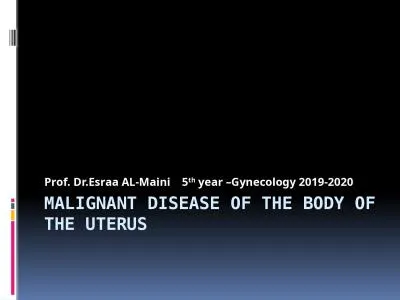

Prof DrEsraa AL Maini 5 th year Gynecology 20192020 Endometrial cancer is now the most common gynecological malignancy worldwide Fourth most common female cancer Account for approximately 30 of all gynecological malignancies ID: 913429
Download Presentation The PPT/PDF document "Malignant Disease of the Body of the Ute..." is the property of its rightful owner. Permission is granted to download and print the materials on this web site for personal, non-commercial use only, and to display it on your personal computer provided you do not modify the materials and that you retain all copyright notices contained in the materials. By downloading content from our website, you accept the terms of this agreement.
Slide1
Malignant Disease of the Body of the Uterus
Prof.
Dr.Esraa
AL-
Maini
5
th
year –
Gynecology
2019-2020
Slide2Endometrial canceris now the most common gynecological malignancy worldwide
Fourth most common female cancer
Account for approximately 30 %of all gynecological malignancies .
The mean age of diagnosis is 62 year
The incidence of endometrial cancer rises sharply in the mid 40s
25%occure before menopause
Slide3Classification
A-
Arising from
endometrium
1-
Adenocarcinoma
,
the most common type of cancer affecting the uterus is there are two distinct types:
A-
Endometrioid
adenocarcinoma
(type 1) account for 90 per cent ,
are
oestrogen
dependent,
occur in younger women and have a good prognosis
B- Papillary serous carcinoma
(type 2).
occur in elderly women, are non-
oestrogen
dependent and have a much poorer prognosis
2-
Clear cell carcinoma
can rarely arise from the
endometrium
.
B
-
Arise from the
stroma
or
myometrium
sarcoma
Slide4Factors Reducing Incidence of Endometrial Cancer:
-Use of the oral contraceptive pill
- progesterone only pill and progesterone injection
-Smoking
-pregnancy
-
Hystrectomy
for patients with lynch syndrome
-IUCD
Mirena
Slide5Risk factors for endometrial cancer
clear association with high circulating levels of
oestrogen
; many of the known risk factors relate to high
oestrogen
levels:
-Obesity
-Diabetes
-
Nulliparous
-Late menopause >52 years
-Unopposed
oestrogen
therapy
-
Tamoxifen
therapy
Tamoxifen
, a selective
oestrogen
receptor modulator (SERM) .
-Hormone replacement therapy
-Family history of colorectal or ovarian cancer . The most common genetic link is with hereditary
nonpolyposis
colorectal cancer s.
Slide6Clinical features:
1-The most common symptom of endometrial cancer is
abnormal vaginal bleeding
90 %
post-menopausal bleeding (PMB -red flag )10% of women with PMB will have a gynecological malignancy.
Common symptoms in pre-menopausal women include
intermenstrual
bleeding (IMB), blood-stained vaginal discharge, heavy menstrual bleeding (HMB), lower abdominal pain or
dyspareunia
.
2- endometrial cancer can be diagnosed by the presence of
abnormal glandular cytology
at the time of a cervical smear.
3-In advanced cancer, patients may present with evidence
metastases
Slide7anc
endometrial carcinoma
Slide8Diagnosis
The mainstays of diagnosis are
-
Transvaginal
ultrasound scanning; endometrial thickness of less than 4 mm, cancer is very unlikely, any measurement more than this will require further assessment.
-Endometrial biopsy by the
Pipelle
or by Dilatation & curettage
-Hysteroscopy directed biopsy
-MRI is often performed: (for staging) and helps to decide on the type of surgical treatment
Slide9Vaginal ultrasound
Slide10Slide11Slide12FIGO staging of carcinoma of the uterus
Although this is a surgical classification, MRI may be offered
1
Confined to uterine body
1a Less than 50% invasion
1b More than 50% invasion
2
Tumour
invading cervical
stroma
3
Local and or regional spread of
3a Invades
serosa
of uterus
3b Invades vagina and/or
parametrium
3c Metastases to pelvic and/or
para
aortic LN
4
Tumour
invades bladder ± bowel
Slide13ManagementSurgery is the recommended treatment
1-Total hysterectomy, bilateral
salpingo-ophorectomy
.
Stage I (grades 1-2
) (3 Grade
the higher grade is more aggressive).
MRI staging suggests disease less than stage 1B
then this surgery is adequate.
This can be performed abdominally or
laparoscopically
(total, vaginally assisted or robotically).
2-Radiotherapy has been proven to be effective for patients that are not candidate for surgery whose disease limited to the uterus .
Slide14Gross involvement
of cervix or If MRI staging suggests cervical involvement
-Radical hysterectomy and
salpingo-ophorectomy
with
pelvic wash for cytology with
Pelvic and
para
-aortic node dissection
I
f the tumor is high grade (grade 3) or papillary serous
as the risk of nodal disease
can be as high as 30% many center performed nodal dissection
Dissection remains controversial as not improve survival
-Radiation for inoperable patients
Slide15Adjuvant treatment
Radiotherapy
:
Postoperative radiotherapy
will reduce the local recurrence rate but not improve survival .
1- local radiotherapy to the vaginal vault given over a short period of time (high-dose radiotherapy, HDR)
2-
External beam radiotherapy
given for locally advanced disease stage in combination with HDR.
Slide16Risk classification for patients with endometrial cancer
Low risk
endometroid
cancer that confined to
endometrium
Intermediate risk stage 1A stage 1B and patients with stage II(invade
myometrium
and occult cervical
stromal
invasion )
High risk gross cervical involvement (stage II
lll
and IV regardless of grade) and papillary and clear cell type
Slide17Low risk adjuvent therapy is not recommended neither radiation nor chemotherapy
Intermediate risk may benefit from post operative radiotherapy
High risk recommended for all patients included radiation and chemotherapy
Slide18PrognosisThe overall five-year survival rate for endometrial cancer is 80 % depending on tumor type, stage and grade of tumor.
Adverse prognostic features for survival include:
advanced age >70 years, high BMI, grade 3 tumors, papillary serous or clear cell
Slide19THANK YOU